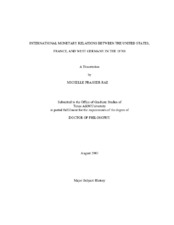| dc.description.abstract | The United States acted unilaterally to terminate the Bretton Woods monetary system in August 1971, and international exchange rate management went from a regime of fixed to floating parities, much to the displeasure of the membership of the European Community. The Nixon, Ford, and Carter administrations adopted policies that heavily benefited U.S. reform objectives and domestic economic goals, which frequently clashed with allied concerns, and damaged American monetary relations with France and West Germany. Yet, the inability of France and the Federal Republic of Germany to form cohesive economic and monetary policies throughout international negotiations or within the European Community (EC), allowed American desires to dictate the path and pace of European integration.
France and Germany attempted, with limited success, to influence U.S. monetary policy through bilateral diplomacy during years of exchange rate fluctuations, dollar devaluations, oil shocks, and payments deficits. Finally, President Valery Giscard d'Estaing and Chancellor Helmut Schmidt created the European Monetary System (EMS) in 1979, reversing the trend of half-hearted attempts at European integration so relevant the decade before. The EMS detached the EC's currencies from the dollar's control, was compatible with the reformed international monetary system, advanced a more independent European monetary identity, and formed the base for future monetary integration. As a result, the EMS, as the birthplace of the Euro, the single European currency launched in 2002, may soon rival the dollar's position as the primary reserve currency.
American monetary policies designed to improve the health of the dollar during the 1970s were a catalyst for European integration. However, as the European Union deepens its economic integration and the Euro grows in strength, it seems that U.S. policies created a regime and a currency that will challenge its dominant position in international monetary affairs. | en |


